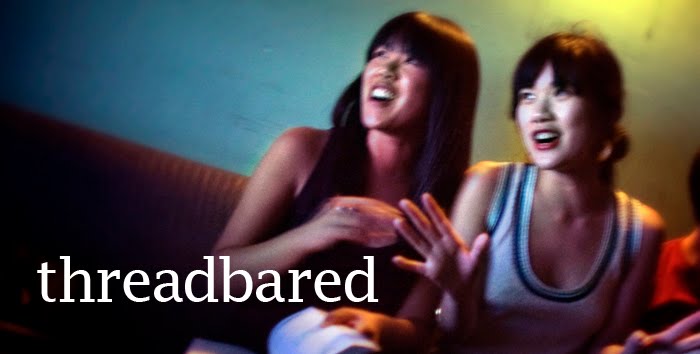 The daily routines that are inhabited easily by some bodies (choosing clothes, shoes, lip color) are for others acts of political and ideological significance, an archive of complicated feelings. Pulling on a pair of jeans or seamed stockings meant for another body, or that once belonged to someone else, might generate an emotional dissonance, or a sense of something out-of-joint or finally put-in-place, or an awareness of danger, or the thrill of forbidden pleasure, or the controlling embrace of that which offers comfort but at an unpredictable price, or new knowledge about the self, about one's own flesh.
The daily routines that are inhabited easily by some bodies (choosing clothes, shoes, lip color) are for others acts of political and ideological significance, an archive of complicated feelings. Pulling on a pair of jeans or seamed stockings meant for another body, or that once belonged to someone else, might generate an emotional dissonance, or a sense of something out-of-joint or finally put-in-place, or an awareness of danger, or the thrill of forbidden pleasure, or the controlling embrace of that which offers comfort but at an unpredictable price, or new knowledge about the self, about one's own flesh.It is to these possibilities that the Lipstick Eater is addressed, also known as Joony Schecter (after the gloriously troublesome Jenny Schecter on The L Word), also known as Joon Oluchi Lee, an assistant professor of gender studies and English at the Rhode Island School of Design, self-described as "a Korea-born, Midwest-bred, Virginia-groomed, Bay Area-harvested faggotron who is above all a black feminist."
On Lipstick Eater, Lee chronicles with care the magpie process of creating for himself a femme faggotry, often drawing from iconic figurations of femininity to spin out another, inevitably more complicated story about how to be, and feel, a girl. Lee ultimately describes the norms but also alternate forms of human intelligibility made possible through the instrumentalization of "boyfriend jeans," a pair of Bettie Page heels, or ripped tights.
The following excerpt from a longer post on handbagging is particularly brilliant, theorizing the complications of seeming submission to the handbag's alterations to the body's movement.
Quite recently, I came to the really obvious realization that I’ve been handbagging it.I was standing in a Muni train, just moderately crowded enough to cozily find a leanspace that allowed me to pull out my book (Mary Gaitskill’s beautiful new anthology, Don’t Cry) and read during my ride. But getting out of the train, I was so rushed at by pre-commuters that I didn’t have a chance to put the book back. Instead, I had to awkwardly maneuver the just-closed book from my hands to one hand, then clasp one edge while pulling the pink block of papered stories to my left breast. As I stepped off the train, a sense memory: a flush of babyfaggot femininity.
There were a couple of reasons why I had this flush of faggoty feminine youth, the central one being that in those few clumsy seconds, I was carrying a handbag. Ah, the catcall of the teenage homophobe: “Nice handbag, faggot!” And please, let’s be clear about this: I was not carrying a man-purse or whatever. This was a straight-up lady handbag, and a roomy one that made me feel like a luxe grunger: a red plaid flannel tote from 3.1 Phillip Lim’s second fall collection. Here’s what defines a true handbag, which also produces its awkward bodily syntax: the handles look broad enough to sling over the shoulder, but is actually just narrow enough to prevent it, therefore forcing the gal to wear it on hanging from her fist or the crook of her arm. The over-the-shoulder model of the handbag is actually an innovation in androgyny, borrowing from the technology of army knapsacks. A true handbag, like most traditional accoutrements of world femininity, hobbles the woman wearer. Holding a bag’s straps in her hand, or immobilizing her arm in a right angle to provide branch for the bag, robs the handbagger of the use of one arm.
Of course, we have been taught that such a robbing is a handicap, when I prefer to think of it as a disability. That is: not being able to use one arm is a profound loss if you understand “ability” as defined by a sparkly healthy body. But the tenets of physical health are often tied to masculine notions of physical boorishness. The logic of which is something like, suppose a bully came after you: how are you supposed to properly defend yourself if one arm is locked in the deadly (but delicious) embrace of a designer handbag?
My answer: well, the handbag doesn’t rob you of the use of your legs, does it? Of course, running away is so un-manly, I guess. Which goes along pretty well with how the mechanics of transporting goods has been gendered: if it allows you free use of your arms, you are pretty able-bodied and more aligned with men. But running away is not the only recourse available to a poor defenseless handbagger. There is a great moment in Jennie Livingston’s film Paris is Burning in which an attitudinous emcee at a drag ball comments on the evening ensemble of a ball walker: “Everybody knows that an evening bag is a must. No lady is safe at night.” In this pretty natural conclusion, the handbag becomes a weapon—that old adage about carrying a brick in your handbag is no joke. The item that hobbles you into femininity is that which can re-arm you. In this way, I think of the handbag as a pretty rad piece of low-fi technology: it physically handicaps you, but simultaneously gives you the prosthetic by which you can transform that handicap into an empowering identity of “the disabled.” The handbag is the ultimate feminine prosthetic.



